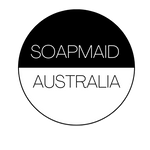
The Pros & Cons of Soap Making Methods (Cold Process, Melt & Pour, Hot Process and Rebatch)
Are you a passionate craft enthusiast looking to dive into the world of soapmaking? Do you want to create stunning, handmade soaps and cosmetics that will impress your friends and family with melt and pour soap base? At SOAPMAID, your trusted source for premium raw materials and DIY ingredients in Australia, we understand your creative aspirations.
We're here to guide you through the pros and cons of various soap-making methods, ensuring that your journey is both enjoyable and successful. Whether you're a seasoned soapmaker or just starting your exciting DIY adventure, this comprehensive exploration of soap-making techniques will help you make an informed choice.
Cold Process Soapmaking
Now, let's get into the fascinating world of Cold Process soapmaking. This classic method, cherished by many artisans, offers several advantages that set the stage for your creative endeavours. With cold process soap making, you can easily customise your soap bars with a wide range of fragrances, colours, and additives. However, it's important to remember that this method does require patience, as the curing time can extend to several weeks.
Pros:
Creativity Unleashed: Cold Process soapmaking provides a canvas for your imagination, allowing you to craft soap bars with endless design possibilities.
Ingredient Control: Take charge of your soap's quality by choosing high-quality ingredients for a premium end product.
Unique Formulas: Experiment with different oils, scents, and colours, creating one-of-a-kind soap bars that reflect your artistic expression.
Artistic Expression: Cold Process soapmaking lets you craft intricate designs and patterns, turning soap into a work of art.
Cons:
- Curing Time: Cold Process soap requires weeks to cure before use.
- Safety Precautions: Handling lye can be hazardous; proper safety measures are crucial.
Melt & Pour Soapmaking
If you're looking for a soap-making method that offers instant gratification, Melt & Pour is your go-to option. With melt-and-pour soap base Australia readily available, this method allows you to create beautiful soap bars in a matter of hours. It's perfect for beginners and those who want to skip the curing process.
Pros:
- Quick and Easy: Achieve impressive results in just a matter of hours, perfect for those seeking immediate satisfaction.
- No Lye Handling: Skip the complexity and potential hazards of handling caustic lye, making it an excellent choice for newcomers.
- Versatile: Dive into a world of possibilities by experimenting with a vibrant spectrum of colours, fragrances, and additives.
- Kid-Friendly: Melt & Pour soapmaking doubles as an enjoyable project for children and beginners, fostering creativity and fun.
Cons:
- Limited Ingredient Control: While versatile, the base quality may vary, limiting your control over certain aspects.
- Less Artistic Freedom: Crafting intricate and complex designs may pose challenges in comparison to other methods.
- Less Unique: Although versatile, similar results can be achieved by others, potentially limiting the uniqueness of your creations.
Hot Process Soapmaking
Hot Process soap making offers a unique twist on traditional methods. It involves cooking the soap mixture, and accelerating the saponification process. This method reduces curing time compared to the Cold Process, but it still requires attention to detail.
Pros:
- Faster Curing: Reduced curing time compared to Cold Process.
- Creative Freedom: Customise with various scents and colours.
- Ingredient Control: Choose quality ingredients.
- Unique Texture: Distinctive, rustic appearance.
Cons:
- Longer Prep Time: Requires more time than Melt & Pour.
- Experience Needed: Some experience with soap making is beneficial.
- Less Precision: Designs may not be as intricate.
Rebatch Soap Making
Rebatch soap making is a great option for recycling soap scraps or salvaging a batch that didn't turn out as expected. It involves grating or melting existing soap, and then remoulding it with new additives.
Pros:
- Waste Reduction: Embrace sustainability by repurposing leftover or failed soap batches, contributing to waste reduction.
- Ingredient Control: Add new ingredients to the mix, allowing you to customise your soap to your preferences.
- Sustainability: Rebatch soap making is an eco-friendly approach, aligning with environmentally conscious values.
Cons:
- Time-Consuming: Melting and reforming soap can be a labour-intensive process, demanding more time and effort.
- Limited Creativity: While customisable, you may experience less freedom compared to other soap making methods in terms of design and ingredients.
- Texture Variations: Keep in mind that the final texture may not always be uniform due to the nature of this method.
The best soap making method depends on your skill level, patience, and creative preferences. Cold Process offers unparalleled artistic freedom, Melt and Pour soap-making is quick and easy, Hot Process accelerates curing, and Rebatch is an eco-conscious choice. Choose the one that suits your needs and start your DIY soap making journey with SOAPMAID.
Are you ready to begin your soapmaking adventure? Visit SOAPMAID's website today to explore a wide range of melt-and-pour soap base Australia, premium raw materials, and DIY ingredients. Sign up and save with our member loyalty points. We're here to support your creative journey every step of the way.
Join SOAPMAID and create your own luxurious, handmade soaps that will leave a lasting impression. Don't miss out—order your supplies now and start crafting your soap making masterpiece!
We deliver Australia wide or click & collect in store in Springvale South, Victoria.
